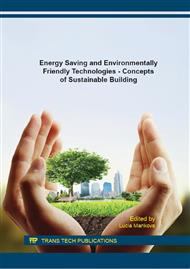p.437
p.445
p.453
p.461
p.469
p.477
p.485
p.493
p.503
Nearly Zero-Energy Buildings & Buildings Built with Industrialized Technology: The Case of Hungary
Abstract:
There is an urgent need nowadays to reduce current levels of GHGs emissions. On the other hand the EU countries are largely dependent on energy imports and are vulnerable to disruption in energy supply which may in turn threaten the functioning of their current economic structure. The EU imported 54% of its energy sources in 2006 and this value was projected to increase even further by 2030. Reducing its import dependency is one of the EU’s main goals of the 20-20 by 2020 target – this legislative package is believed to reduce the expected imports of energy by 26% compared to the development before the 20-20 initiative.One of the most important environmental problems is the energy consumption of the buildings. Current paper shows that buildings built with industrialized technology can deliver large energy and GHG emission reductions at low costs.Only 1-2% part of the building stock is exchanged every year, so it is very important to increase the energy efficiency of the existing buildings, too.Present paper focuses on the buildings built with industrialized technology only, and their potential in nearly zero-energy buildings sector. Up till now the Central European support schemes concentrated most financial resources on buildings built with prefabricated technology. Present paper explains the past and present of the “panel” problem in Hungary with a short outlook to some other countries.
Info:
Periodical:
Pages:
469-476
Citation:
Online since:
January 2016
Authors:
Price:
Сopyright:
© 2016 Trans Tech Publications Ltd. All Rights Reserved
Share:
Citation:


